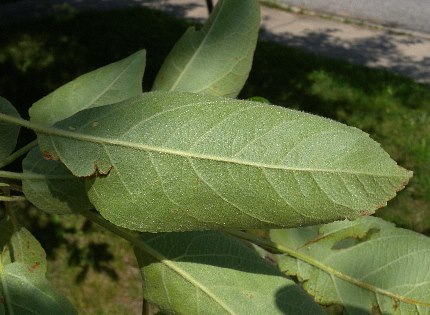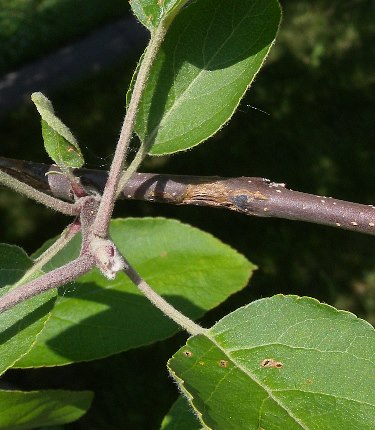
Relatively large flowers about 1¼-2" across are produced in small clusters from short spur twigs. Individual flowers have 5 rounded petals that are pinkish white to white and contracted at their bases, 5 lanceolate sepals that are pale gray-green and downy from short fine hairs, numerous stamens (about 20) with yellow anthers, and an inferior ovary with 5 styles. The sepals are much smaller than the petals. The slender pedicels are pale gray-green and downy from short fine hairs. The blooming period occurs during late spring for about 2 weeks (after the vernal leaves have unfolded). The flowers are fragrant. Fertile flowers are replaced by small green pomes that develop during the summer. At maturity during late summer or fall, the pomes are 1½-4" across and more or less globoid in shape; each pome has a depression at its top and bottom. The exterior of mature pomes is usually greenish red or red (rarely yellow) and glabrous or nearly so; sometimes short fine hairs occur within the depressions of each pome. The fleshy interior of mature pomes is greenish white to pale yellow, crisp, and somewhat juicy; the flavor can be sour, sweet-sour, or sweet. Within the central portion of each pome, there are up to 10 brown seeds. These small seeds are ovoid and flattened. The deciduous leaves usually turn yellow during the autumn.

Cultivation: The preference is full sun, moist to mesic well-drained conditions, and fertile loamy soil. The cultivated Apple is vulnerable to many insect pests and disease organisms, although some cultivars have greater resistance to them than others. Dwarf cultivars are available that produce full-sized fruit on trees less than 10' tall.
Range & Habitat: As a naturalized tree, the non-native Apple is occasional in NE Illinois and uncommon elsewhere (see Distribution Map). It was introduced from Eurasia into North America. Habitats for naturalized trees include woodland borders, disturbed meadows, abandoned orchards and old homesteads, areas along roads, and fence rows. Apple is often cultivated for its large edible fruit and it is used as an ornamental landscape tree. When it escapes from cultivation, Apple is not aggressive and invasive. The fruits of escaped trees are usually smaller than those of cultivated trees. Apple is vulnerable to wildfires.

Faunal Associations: The flowers must be cross-pollinated by insects from other compatible trees, otherwise Apple does not set fruit. Bees are the most important visitors of the flowers, where they seek nectar or pollen. Typical bee visitors are little carpenter bees (Ceratina spp.), large carpenter bees (Xylocopa virginica), cuckoo bees (Nomada spp.), and Andrenid bees (Andrena spp.); see Wilhelm & Rericha (2017) and Krombein et al. (1979). Honey bees, bumblebees, digger bees (Synhalonia spp.), and mason bees (Osmia spp.) visit the flowers of apple too. Other insects, like butterflies and skippers, are likely visitors of these flowers, but they tend to be less common and they are less important for cross-pollination. Other insects eat the foliage, suck plant juices, bore through the wood, or feed destructively on the fruit and flowers of these trees. Examples of such insects include larvae of wood-boring beetles, leaf beetles, plant bugs, stink bugs, aphids, leafhoppers, treehoppers, armored scale insects, mealybugs, thrips, larvae of many moths, and larvae of some butterflies. These butterfly species are the Striped Hairstreak (Satyrium liparops strigosum), Viceroy (Limenitis archippus), Red-spotted Purple (Limenitis arthemis astyanax), and Tiger Swallowtail (Papilio glaucus). The Insect Table provides a list of these insect feeders, although there are many more.

Some vertebrate animals also use Apple trees as a food source. Because the fruits of cultivated apple trees are so large, they tend to be eaten more often by mammals than birds, although birds sometimes peck at their fruits. Mammals that eat the fruits include the American Black Bear, White-tailed Deer, Red Fox, Gray Fox, Opossum, Striped Skunk, Fox Squirrel, and North American Porcupine. Various voles sometimes feed on fallen fruits, and they may gnaw on the bark of Apple saplings during the winter. White-tailed Deer, Elk, and some domesticated livestock occasionally browse on the foliage or twigs. The Cottontail Rabbit and North American Porcupine sometimes gnaw on the bark of these trees (Martin et al., 1951/1961; Kurz, 2004; Haugen, 1942; Schneider et al., 2006; Beeman & Pelton, 1980). Among birds, the buds of Apple trees are eaten by the Ruffed Grouse, Purple Finch, and White-throated Sparrow. Their fruits are eaten or pecked at by the introduced Monk Parakeet (in the Chicago area), Carolina Parakeet (now extinct), Ring-necked Pheasant, European Starling, Red-bellied Woodpecker, Baltimore Oriole, American Robin, and other birds (DeGraaf, 2002; DeVore et al., 2004; Kurz, 2004; Martin et al., 1951/1961; Snyder, 2004). Apple trees also provide cover and nesting habitat for several species of birds. By consuming the fruits of Apple, many mammals spread the seeds of this tree to new locations. Humans also spread the seeds when they throw apple cores out of car windows, or toss them aside along paths in natural areas.
Photographic Location: A small tree along a sidewalk in Urbana, Illinois.

Comments: This is the domesticated Apple tree that occasionally escapes from cultivation. In the published literature and on the internet, a confusing variety of scientific names refer to this tree: Malus communis, Malus domestica, Malus pumila, Malus sylvestris, and Pyrus malus. Of these, Malus pumila is the preferred scientific name for both cultivated and naturalized Apple trees. Because naturalized trees may hybridize with other Malus spp. (Crab Apples), identification of wild trees can be difficult, particularly around urban and suburban areas. In general, Apple has larger fruits (1½" across or more) than Crab Apples. It also has leaves that are short-pubescent on their undersides and they lack lateral lobes. The native Crab Apples have smaller greenish yellow fruits and their leaves are often shallowly lobed. Another cultivated species that sometimes escapes, Malus baccata (Siberian Crab Apple), also has smaller fruits and its leaf undersides are hairless.